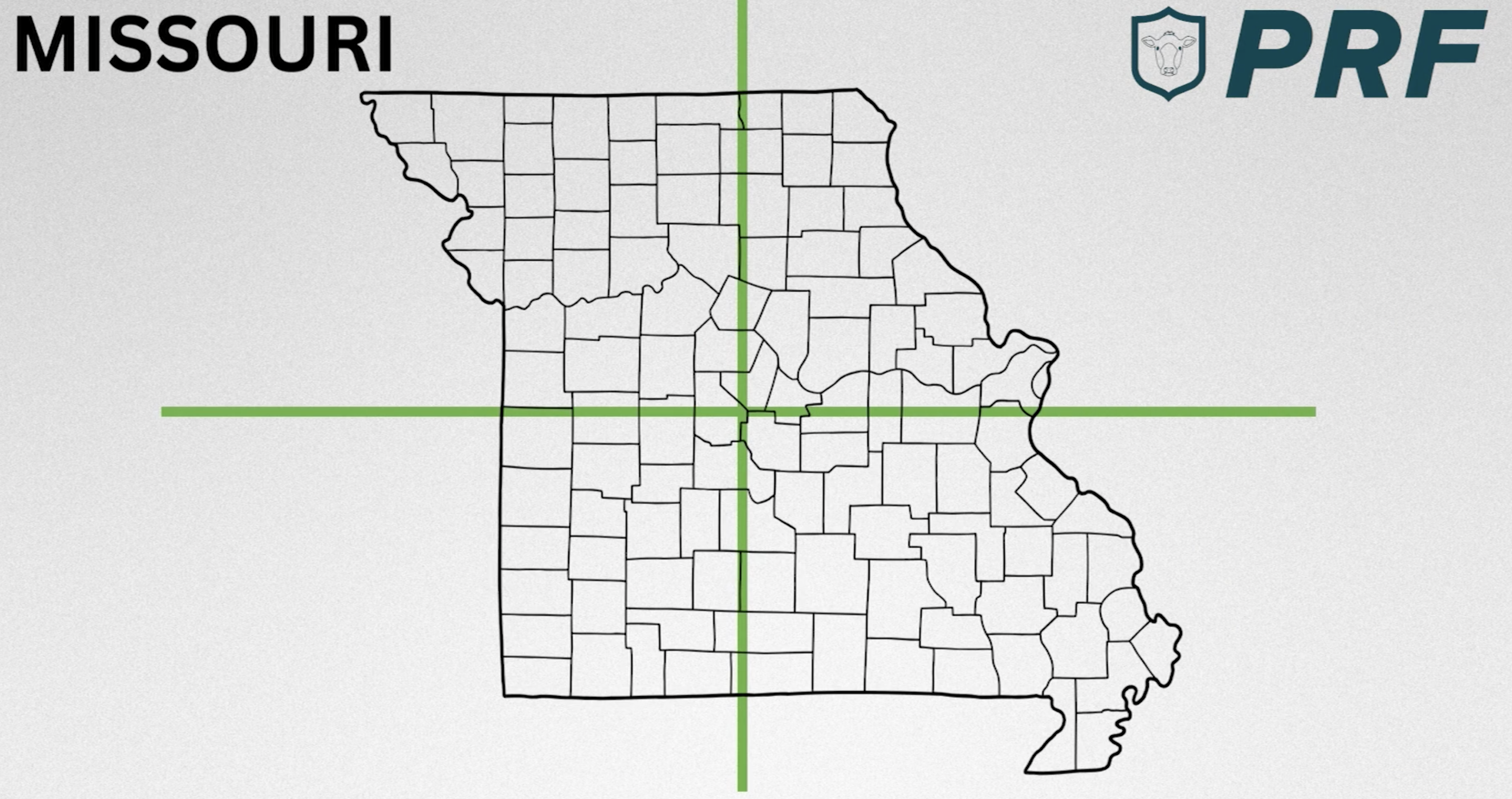Is “Average” Changing in Your Area in MO? Missouri Precipitation Trends Are Changing
By Lucy Sledge
Ranchers’ operations can be drastically affected by weather conditions and there is nothing we can do to change the weather. We can only change how we react and prepare for what conditions are thrown at us.
One great risk management tool is Pasture Rangeland, Forage (PRF) Insurance which provides loss payments when the area has a below average precipitation. When this insurance tool’s triggering factor is pegged to an average, it is vital to know if precipitation trends are changing in your area.
Are conditions getting drier in the central part of the country? Is there a higher likelihood of below-average rainfall or snowfall for certain months? When deciding on Pasture, Rangeland, and Forage (PRF) insurance it is important to know if there is a higher frequency of below-average precipitation and for which months.
I looked at precipitation trends in Missouri, North Dakota, and South Dakota over 30-year and 10-year timescales, from 1994 and 2014, respectively. I used USDA PRF grid cell data for four grid cells from each region of the state (Northwest, Southwest, Northeast, and Southeast) and counted the number of above-average years versus below-average years. I did this for each of the 11 monthly ranges USDA provided and averaged the grid cells for the region to give us a general sense of trends.
For simplicity, I then turned the “counts” of below versus above average into percentages to directly compare 10-year and 30-year frequency. You will notice that in the 10-year trends, there are non-even percentages; for example, 75% of July-August periods which would suggest 7.5 out of the last 10 years, and the uneven number is attributed to the averaging of multiple grid cells. Because PRF triggers not by the percentage by which we are below average just that we see less than 100% of average precipitation, I will talk about above or below average precipitation years in terms of frequency, not quantity at which they are above or below average.
However, for context, I’ve selected a “representative” official National Weather Service reporting site for annual precipitation totals. In highlighting annual precipitation trends we can gain further insight into if years have been getting overall drier – i.e. those PRF below-average periods may be more drastic. In the graphs below, precipitation for each year over the last 30 years is displayed as a dotted line, and the solid line illustrates the trend.
Please note that the average precipitation is on rolling averages and may not directly line up with PRF Insurance precipitation triggers. These averages are also based on large regions of a state and do not correlate to any one specific grid. These averages should be used for context and not to decide coverages. Talk to a PRM Risk Management Advisor for interval selection recommendations.
NORTHWEST MISSOURI
Northwest Missouri is the only region in the state to see a small decrease (less than 1”) in annual precipitation over the last 30 years.
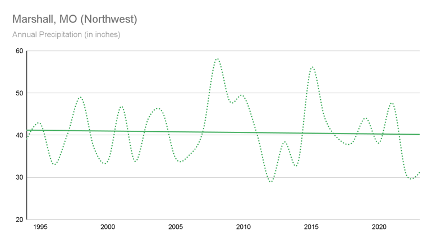
Using PRF data to break this down monthly, shows below-average precipitation is most likely from September through February with six of the last 10 years experiencing below-average precipitation. Our largest change over 30 years is during April, May, and June, where we now see a higher likelihood of below-average rainfall – from 50% chance to 60%. The most likely months to experience below-average precipitation are from September through January with an increasing frequency of below-average precipitation from April – June.
Our summer months have the highest likelihood of seeing above-average rainfall with over 70% of years having above-average rain in June to August. February and March also have more frequent above-average years than below, with above-average conditions every year since 2019.

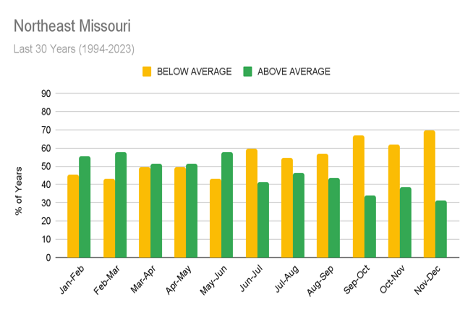
SOUTHEAST MISSOURI
In the last three decades, southeast Missouri has seen more annual precipitation. However, this is a snapshot of an entire year where below-average months can be “evened out” by overly wet months. To get a sense of precipitation trends for the southeast region, we can dive into the PRF data periods that break down above or below-average precipitation by month.
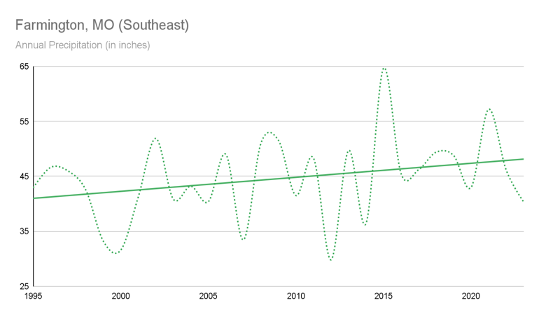
Over the last 10 years, we have had above-average precipitation from January to August, with the highest frequency of above-average rainfall during April, May, July, and August. There is an increasing frequency of above-average rainfall during the late Spring and Summer months with roughly 70-80% of years seeing above-average rainfall since 2014, compared to 60% since 1994. On the other hand, the most likely months to have below-average precipitation are August to December. In the last 10 years, 80% of the November – December periods have been below average, compared to 70% in 30 years. The frequency of below-average precipitation from September through December is increasing.
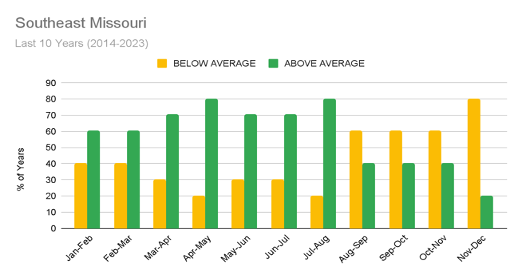

SOUTHWEST MISSOURI
Much like the southeast and northeast regions of Missouri, the southwest part of the state has also seen a steady increase in annual precipitation over the last 30 years. Once again though, we need to dive into the monthly PRF data to determine what times of year are most likely to be below versus above average.
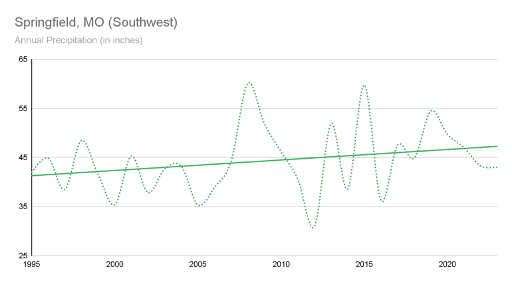
In the last 10 years, our most likely months to have below-average precipitation are August and September and again in November and December, with six of the last 10 years having below-average precipitation in these months. In the last 10 years, the biggest changes have been more frequent below-average conditions in January – February and June – July. So while we may be seeing an increase in the amount of annual precipitation, the wet months are getting wetter, and the dry periods are more frequent. The most likely months for experiencing below-average conditions are August through January and an increasing likelihood of drier-than-average conditions from June to July.
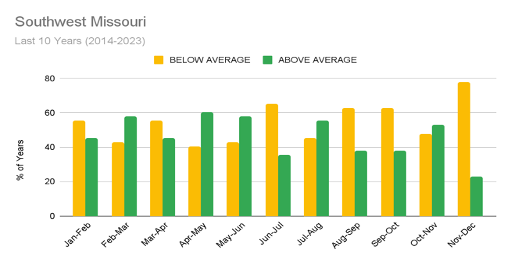
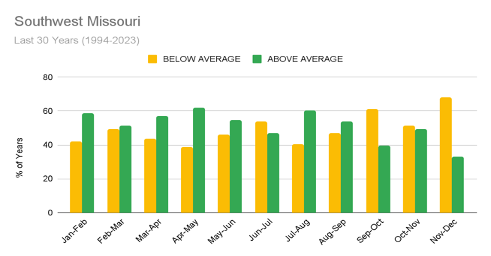
Conclusion
Though every region in Missouri has seen a small increase in annual precipitation, when we break down the data by PRF period we see our most likely time of year to have below-average precipitation is from the Fall into early Winter (from September through January). On the west side of the state, there is an increasing frequency of below-average precipitation from April through July too. In northeast Missouri, there is an increasing frequency of below-average conditions in February.
So is it getting drier? For the Dakotas, annual precipitation has been trending downward over the last 30 years and the frequency of below-average periods is increasing. In Missouri, the answer isn’t that simple – while yearly precipitation may have increased slightly over three decades, monthly examination indicates an increasing frequency of below-average periods.
In many cases, the periods that displayed a higher frequency of below-average years since 1994 continue to display this in the last 10 years, and at a higher frequency too. The months that already tended to be below average continue to do so in the last decade. Furthermore, though we have seen some small increases in the frequency of wetter-than-average conditions, for many regions the number of wet periods versus dry has not drastically increased in the last 10 years.
Disclaimer: This report is not a recommendation or advice for crop insurance coverage. Talk to a licensed Risk Management Advisor for any policy recommendations. Precision Risk Management is an equal opportunity provider. Go to PrecisionRiskManagement.com/legal for all disclosures.

